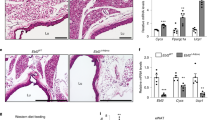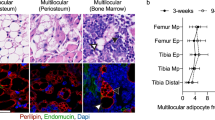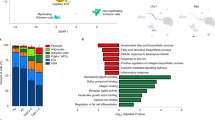Abstract
Uncoupling protein 1 (UCP1) is highly expressed in brown adipose tissue, where it generates heat by uncoupling electron transport from ATP production. UCP1 is also found outside classical brown adipose tissue depots1,2,3,4, in adipocytes that are termed 'brite' (brown-in-white) or 'beige'. In humans, the presence of brite or beige (brite/beige) adipocytes is correlated with a lean, metabolically healthy phenotype5,6,7,8, but whether a causal relationship exists is not clear. Here we report that human brite/beige adipocyte progenitors proliferate in response to pro-angiogenic factors, in association with expanding capillary networks. Adipocytes formed from these progenitors transform in response to adenylate cyclase activation from being UCP1 negative to being UCP1 positive, which is a defining feature of the beige/brite phenotype, while displaying uncoupled respiration. When implanted into normal chow-fed, or into high-fat diet (HFD)-fed, glucose-intolerant NOD-scid IL2rgnull (NSG) mice, brite/beige adipocytes activated in vitro enhance systemic glucose tolerance. These adipocytes express neuroendocrine and secreted factors, including the pro-protein convertase PCSK1, which is strongly associated with human obesity. Pro-angiogenic conditions therefore drive the proliferation of human beige/brite adipocyte progenitors, and activated beige/brite adipocytes can affect systemic glucose homeostasis, potentially through a neuroendocrine mechanism.
This is a preview of subscription content, access via your institution
Access options
Subscribe to this journal
Receive 12 print issues and online access
$209.00 per year
only $17.42 per issue
Buy this article
- Purchase on Springer Link
- Instant access to full article PDF
Prices may be subject to local taxes which are calculated during checkout




Similar content being viewed by others
Accession codes
References
Collins, S. A heart-adipose tissue connection in the regulation of energy metabolism. Nat. Rev. Endocrinol. 10, 157–163 (2014).
Lee, Y.H., Petkova, A.P., Mottillo, E.P. & Granneman, J.G. In vivo identification of bipotential adipocyte progenitors recruited by β3-adrenoceptor activation and high-fat feeding. Cell Metab. 15, 480–491 (2012).
Shabalina, I.G. et al. UCP1 in brite/beige adipose tissue mitochondria is functionally thermogenic. Cell Reports 5, 1196–1203 (2013).
Harms, M. & Seale, P. Brown and beige fat: development, function and therapeutic potential. Nat. Med. 19, 1252–1263 (2013).
Nedergaard, J., Bengtsson, T. & Cannon, B. Unexpected evidence for active brown adipose tissue in adult humans. Am. J. Physiol. Endocrinol. Metab. 293, E444–E452 (2007).
Cypess, A.M. et al. Identification and importance of brown adipose tissue in adult humans. N. Engl. J. Med. 360, 1509–1517 (2009).
van Marken Lichtenbelt, W.D. et al. Cold-activated brown adipose tissue in healthy men. N. Engl. J. Med. 360, 1500–1508 (2009).
Lidell, M.E., Betz, M.J. & Enerbäck, S. Two types of brown adipose tissue in humans. Adipocyte 3, 63–66 (2014).
Crandall, D.L., Hausman, G.J. & Kral, J.G. A review of the microcirculation of adipose tissue: anatomic, metabolic, and angiogenic perspectives. Microcirculation 4, 211–232 (1997).
Han, J. et al. The spatiotemporal development of adipose tissue. Development 138, 5027–5037 (2011).
Bouloumié, A., Lolmède, K., Sengenès, C., Galitzky, J. & Lafontan, M. Angiogenesis in adipose tissue. Ann. Endocrinol. (Paris) 63, 91–95 (2002).
Tang, W. et al. White fat progenitor cells reside in the adipose vasculature. Science 322, 583–586 (2008).
Gupta, R.K. et al. Zfp423 expression identifies committed preadipocytes and localizes to adipose endothelial and perivascular cells. Cell Metab. 15, 230–239 (2012).
Gealekman, O. et al. Depot-specific differences and insufficient subcutaneous adipose tissue angiogenesis in human obesity. Circulation 123, 186–194 (2011).
Tran, K.V. et al. The vascular endothelium of the adipose tissue gives rise to both white and brown fat cells. Cell Metab. 15, 222–229 (2012).
van de Vyver, M., Andrag, E., Cockburn, I.L. & Ferris, W.F. Thiazolidinedione-induced lipid droplet formation during osteogenic differentiation. J. Endocrinol. 223, 119–132 (2014).
Wu, J. et al. Beige adipocytes are a distinct type of thermogenic fat cell in mouse and human. Cell 150, 366–376 (2012).
Cypess, A.M. et al. Activation of human brown adipose tissue by a β3-adrenergic receptor agonist. Cell Metab. 21, 33–38 (2015).
Cousin, B. et al. Occurrence of brown adipocytes in rat white adipose tissue: molecular and morphological characterization. J. Cell Sci. 103, 931–942 (1992).
Orlicky, D.J., Monks, J., Stefanski, A.L. & McManaman, J.L. Dynamics and molecular determinants of cytoplasmic lipid droplet clustering and dispersion. PLoS One 8, e66837 (2013).
Marcinkiewicz, A., Gauthier, D., Garcia, A. & Brasaemle, D.L. The phosphorylation of serine 492 of perilipin a directs lipid droplet fragmentation and dispersion. J. Biol. Chem. 281, 11901–11909 (2006).
Zhang, Y., Matheny, M., Zolotukhin, S., Tumer, N. & Scarpace, P.J. Regulation of adiponectin and leptin gene expression in white and brown adipose tissues: influence of beta3-adrenergic agonists, retinoic acid, leptin and fasting. Biochim. Biophys. Acta 1584, 115–122 (2002).
Behan, J.W. et al. Activation of adipose tissue macrophages in obese mice does not require lymphocytes. Obesity (Silver Spring) 21, 1380–1388 (2013).
Xiao, C., Goldgof, M., Gavrilova, O. & Reitman, M.L. Anti-obesity and metabolic efficacy of the β3-adrenergic agonist, CL316243, in mice at thermoneutrality compared to 22°C. Obesity (Silver Spring) 23, 1450–1459 (2015).
Hocking, S.L. et al. Subcutaneous fat transplantation alleviates diet-induced glucose intolerance and inflammation in mice. Diabetologia 58, 1587–1600 (2015).
Wang, G.X. et al. The brown fat-enriched secreted factor Nrg4 preserves metabolic homeostasis through attenuation of hepatic lipogenesis. Nat. Med. 20, 1436–1443 (2014).
Jackson, R.S. et al. Obesity and impaired prohormone processing associated with mutations in the human prohormone convertase 1 gene. Nat. Genet. 16, 303–306 (1997).
Benzinou, M. et al. Common nonsynonymous variants in PCSK1 confer risk of obesity. Nat. Genet. 40, 943–945 (2008).
Denning, G.M. et al. Proenkephalin expression and enkephalin release are widely observed in non-neuronal tissues. Peptides 29, 83–92 (2008).
Miller, A.M. et al. Interleukin-33 induces protective effects in adipose tissue inflammation during obesity in mice. Circ. Res. 107, 650–658 (2010).
Brestoff, J.R. et al. Group 2 innate lymphoid cells promote beiging of white adipose tissue and limit obesity. Nature 519, 242–246 (2015).
Shinoda, K. et al. Genetic and functional characterization of clonally derived adult human brown adipocytes. Nat. Med. 21, 389–394 (2015).
Xue, R. et al. Clonal analyses and gene profiling identify genetic biomarkers of the thermogenic potential of human brown and white preadipocytes. Nat. Med. 21, 760–768 (2015).
Nishio, M. et al. Production of functional classical brown adipocytes from human pluripotent stem cells using specific hemopoietin cocktail without gene transfer. Cell Metab. 16, 394–406 (2012).
Elias, I. et al. Adipose tissue overexpression of vascular endothelial growth factor protects against diet-induced obesity and insulin resistance. Diabetes 61, 1801–1813 (2012).
Sun, K. et al. Dichotomous effects of VEGF-A on adipose tissue dysfunction. Proc. Natl. Acad. Sci. USA 109, 5874–5879 (2012).
Chang, L. et al. Loss of perivascular adipose tissue on peroxisome proliferator-activated receptor-γ deletion in smooth muscle cells impairs intravascular thermoregulation and enhances atherosclerosis. Circulation 126, 1067–1078 (2012).
Fitzgibbons, T.P. et al. Similarity of mouse perivascular and brown adipose tissues and their resistance to diet-induced inflammation. Am. J. Physiol. Heart Circ. Physiol. 301, H1425–H1437 (2011).
Rojas-Rodriguez, R. et al. Adipose tissue angiogenesis assay. Methods Enzymol. 537, 75–91 (2014).
Brehm, M.A. et al. Engraftment of human HSCs in nonirradiated newborn NOD-scid IL2rγnull mice is enhanced by transgenic expression of membrane-bound human SCF. Blood 119, 2778–2788 (2012).
Shabalina, I.G., Kramarova, T.V., Nedergaard, J. & Cannon, B. Carboxyatractyloside effects on brown-fat mitochondria imply that the adenine nucleotide translocator isoforms ANT1 and ANT2 may be responsible for basal and fatty-acid-induced uncoupling respectively. Biochem. J. 399, 405–414 (2006).
Acknowledgements
This study was funded by US National Institutes of Health grants R01DK089101 (to S.C.), R24OD018259 (to M.A.B.), R01DK089185 (to M.P.C.), R01-DK080756, R01-DK079999, R24-DK090963 and U24-DK093000 (all to J.K.K.), and American Heart Association grant 12FTF11260010 (to T.F.). The authors acknowledge the use of the University of Massachusetts (UMASS) Flow Cytometry Core, the UMASS Genomics Core, the UMASS Mouse Phenotyping Center and the UMASS Morphology Core for conducting these studies.
Author information
Authors and Affiliations
Contributions
S.Y.M., S.C., M.A.B. and M.P.C. designed the experiments; S.Y.M. and R.R.-R. obtained adipose tissue, generated cells and performed experiments on cells; J.K. and S.Y.M. performed experiments on mice; A.B., M.N., T.F. and M.P.C. obtained and analyzed perivascular adipose tissue samples; J.H.K., H.-L.N. and J.K.K. performed and analyzed metabolic phenotyping experiments. S.Y.M. and S.C. wrote the manuscript. All authors contributed to editing the manuscript. S.C. managed the project.
Corresponding author
Ethics declarations
Competing interests
The authors declare no competing financial interests.
Supplementary information
Supplementary Text and Figures
Supplementary Figure 1–4 and Supplementary Table 1–2 (PDF 808 kb)
Rights and permissions
About this article
Cite this article
Min, S., Kady, J., Nam, M. et al. Human 'brite/beige' adipocytes develop from capillary networks, and their implantation improves metabolic homeostasis in mice. Nat Med 22, 312–318 (2016). https://doi.org/10.1038/nm.4031
Received:
Accepted:
Published:
Issue Date:
DOI: https://doi.org/10.1038/nm.4031
This article is cited by
-
Fibroblastic reticular cells in lymph node potentiate white adipose tissue beiging through neuro-immune crosstalk in male mice
Nature Communications (2023)
-
The evolving functions of the vasculature in regulating adipose tissue biology in health and obesity
Nature Reviews Endocrinology (2023)
-
Wnt signaling preserves progenitor cell multipotency during adipose tissue development
Nature Metabolism (2023)
-
Pharmacological modulation of adaptive thermogenesis: new clues for obesity management?
Journal of Endocrinological Investigation (2023)
-
Irisin mediates beiging of adipose-derived mesenchymal stem cells through binding to TRPC3
BMC Biology (2022)



